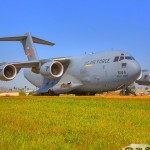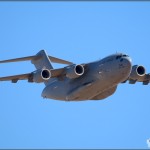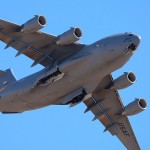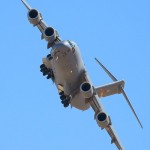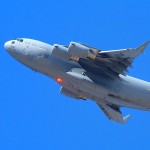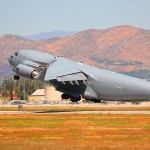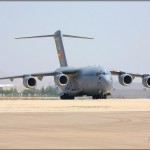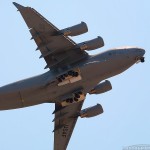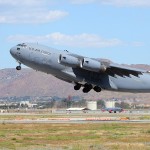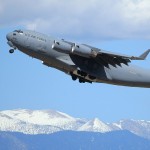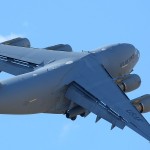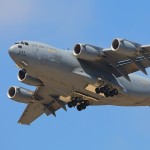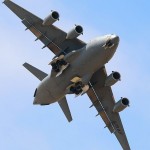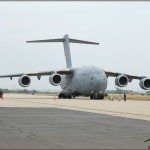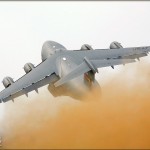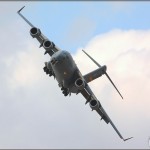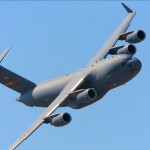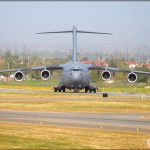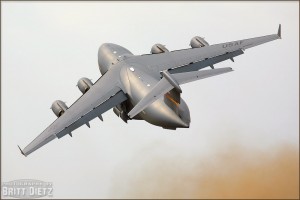 If you live around Long Beach, California, no doubt you’ve heard them lumbering through the skies announcing their arrival with loud roars.  If you’ve been to airshows, you’ve seen them performing incredible maneuvers during their demonstrations which never get old and always make the crowd’s mouths hang open.  It is the second largest airlift aircraft in the United States Air Force (and the entire military all together) created by a company no stranger to large complex aircraft through the history of the United States: Boeing.  Serving with 6 different counties including the United States, this massive aircraft has set the bar for all future transport and cargo aircraft from now on, paving the way with it’s four massive Pratt & Whitney F117-PW-100 turbofan engines that provide an amazing 40,440 pounds of thrust including reverse thrusting for taxiing backwards.  So what aircraft can do all of this?  None other than the amazing Boeing C-17A Globemaster III.
If you live around Long Beach, California, no doubt you’ve heard them lumbering through the skies announcing their arrival with loud roars.  If you’ve been to airshows, you’ve seen them performing incredible maneuvers during their demonstrations which never get old and always make the crowd’s mouths hang open.  It is the second largest airlift aircraft in the United States Air Force (and the entire military all together) created by a company no stranger to large complex aircraft through the history of the United States: Boeing.  Serving with 6 different counties including the United States, this massive aircraft has set the bar for all future transport and cargo aircraft from now on, paving the way with it’s four massive Pratt & Whitney F117-PW-100 turbofan engines that provide an amazing 40,440 pounds of thrust including reverse thrusting for taxiing backwards.  So what aircraft can do all of this?  None other than the amazing Boeing C-17A Globemaster III.
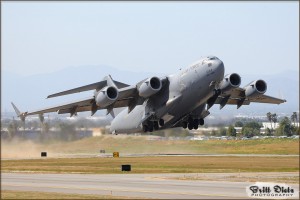 The c-17 was developed in 1985 to replace the C-130 Hercules as a tactical airlifter. Â Running a year behind schedule, the first flight of the C-17 was on September 15, 1991 at Long Beach, California. Â Following a lot of troubled performance issues, Boeing worked really hard and solved all the concerns that the US Air Force had, and the first squadron of C-17s became active in 1995. Â The C-17 is 174 feet long and has a wingspan of 170 feet. It can land on runways shorter than 3,500 feet, including gravel and dirt ones, due to the reverse thrusting capabilities. It can carry 170,900Â pounds of equipment, troops, supplies, and more! Â The C-17 has not only worked in combat situations, but also humanitarian relief missions where it has brought in supplies from all around the United States and the world. Â Currently, the United States has just over 200 C-17A Globemaster III aircraft in US bases around the world.
The c-17 was developed in 1985 to replace the C-130 Hercules as a tactical airlifter. Â Running a year behind schedule, the first flight of the C-17 was on September 15, 1991 at Long Beach, California. Â Following a lot of troubled performance issues, Boeing worked really hard and solved all the concerns that the US Air Force had, and the first squadron of C-17s became active in 1995. Â The C-17 is 174 feet long and has a wingspan of 170 feet. It can land on runways shorter than 3,500 feet, including gravel and dirt ones, due to the reverse thrusting capabilities. It can carry 170,900Â pounds of equipment, troops, supplies, and more! Â The C-17 has not only worked in combat situations, but also humanitarian relief missions where it has brought in supplies from all around the United States and the world. Â Currently, the United States has just over 200 C-17A Globemaster III aircraft in US bases around the world.
I’ve always admired the C-17 and their crews.  They put on one heck of a demonstration at Airshows around the world, and I knew thought I’d ever get as excited as I do seeing to see a transport airlifter, the C-17, performing at a show.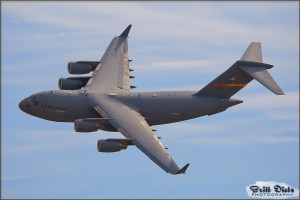 There’s something about the sheer size of the C-17, and the way it maneuvers like a giant fighter. Watching it’s wings dip incredibly fast as it banks around in a turn stops you in your tracks, and makes your eyes go skyward.  With the amazing fly by wire system and a joystick instead of a yoke for the pilots, the C-17 can maneuver and turn in ways you never thought possible for something like this.  To see the massive grey aircraft almost flip vertical in an instant makes you wonder what it must feel like to be on the inside of the aircraft as it does these unbelievable pitches, something I’ve always wondered myself.  I’ve been inside C-17s at airshows many times, I’ve walked through the massive interior and sat in the same seats paratroopers have.  I always imagined it’d be fun to ride in, but the possibility for me to take part in one of these rides seemed near impossible that I hadn’t bothered to try.  I’d always watch media board the C-17, and wonder if one of these days I should request a media flight, but I always end up preferring to be in the crowd as often times they have a better photographic vantage point than the media do.  But this all changed this year in 2010, when I found myself on a C-17 flight.
There’s something about the sheer size of the C-17, and the way it maneuvers like a giant fighter. Watching it’s wings dip incredibly fast as it banks around in a turn stops you in your tracks, and makes your eyes go skyward.  With the amazing fly by wire system and a joystick instead of a yoke for the pilots, the C-17 can maneuver and turn in ways you never thought possible for something like this.  To see the massive grey aircraft almost flip vertical in an instant makes you wonder what it must feel like to be on the inside of the aircraft as it does these unbelievable pitches, something I’ve always wondered myself.  I’ve been inside C-17s at airshows many times, I’ve walked through the massive interior and sat in the same seats paratroopers have.  I always imagined it’d be fun to ride in, but the possibility for me to take part in one of these rides seemed near impossible that I hadn’t bothered to try.  I’d always watch media board the C-17, and wonder if one of these days I should request a media flight, but I always end up preferring to be in the crowd as often times they have a better photographic vantage point than the media do.  But this all changed this year in 2010, when I found myself on a C-17 flight.
The Riverside Airport Airshow is held annually each year in April or March and often is considered one of the first large airshows for Southern California. A wonderful mix of modern and vintage aircraft appear at this show, and often there’s headlining and rare aircraft that make appearances and perform for the packed crowds.  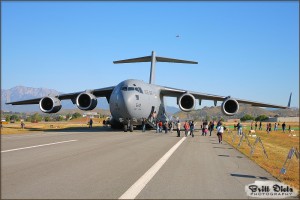 The US Air Force and US Navy usually send out some demo fighter aircraft to perform at the show, and the massive car show that is on display at the airport completes the air and ground sights to see.  The airshow is only one day, so the casual crowds come out in huge numbers along with photographers and aviation fans.  The Riverside Airport Airshow has been around for 18 years, growing with each airshow in popularity and size with over 70,000 attendees and 200 acres of aircraft and cars on display.  For more information on the Riverside Airshow for next year, being held on March 26, 2011 you can click here for their website.  I’ve attended this airshow for many years now, having shot the 2008, 2009, and the 2010 Airshow at Riverside.  One of the star performers that have graced Riverside and almost dwarfed the entire airport with it’s sheer size is the C-17.  Making it’s first appearance in 2007 at the airshow from the very nearby March Air Reserve Base where many C-17s are based and call home, one of the most amazing places to watch a C-17 take-off and demonstrate it’s short runway takeoff and landings is the Riverside Airshow.  While it’s amazing to watch, I was able to experience these short field capabilities of the C-17 first hand…
The US Air Force and US Navy usually send out some demo fighter aircraft to perform at the show, and the massive car show that is on display at the airport completes the air and ground sights to see.  The airshow is only one day, so the casual crowds come out in huge numbers along with photographers and aviation fans.  The Riverside Airport Airshow has been around for 18 years, growing with each airshow in popularity and size with over 70,000 attendees and 200 acres of aircraft and cars on display.  For more information on the Riverside Airshow for next year, being held on March 26, 2011 you can click here for their website.  I’ve attended this airshow for many years now, having shot the 2008, 2009, and the 2010 Airshow at Riverside.  One of the star performers that have graced Riverside and almost dwarfed the entire airport with it’s sheer size is the C-17.  Making it’s first appearance in 2007 at the airshow from the very nearby March Air Reserve Base where many C-17s are based and call home, one of the most amazing places to watch a C-17 take-off and demonstrate it’s short runway takeoff and landings is the Riverside Airshow.  While it’s amazing to watch, I was able to experience these short field capabilities of the C-17 first hand…
A week or two before the airshow, I was chatting with a fellow photographer friend of mine about the upcoming Riverside show. Â He mentioned that he was going to be media at the show, and asked if I was as well. Â I replied no, that I didn’t see the point of going to all the trouble of being media when I’d be shooting from a crowd location anyway where all the photographers normally hang out during the show. Â 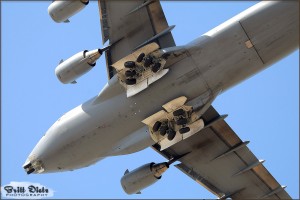 He mentioned, in reply, that it was too bad as the C-17 flight was a lot of fun (he’d been on them a few times before). Â Remarking that I’d never been on a C-17 flight and would love to one day, he said he’d see what he could do for the media day flight. Â Media Day is usually a special preview of the airshow where media and press are invited only and they can either watch aircraft fly that will be flying at the airshow, or take part in a flight of some sort where afterwards they can conduct interviews with show officials and pilots for the various media outlets. Naturally, this close to the media day, I wasn’t expecting anything since the deadline for media applications had already passed. Â A day or two later, however, I got a phone call from him saying he’d gotten me on the list. Â Amazed that I was able to be slipped in so fast and a bit in shock, it didn’t quite hit me until much later that I’d actually be flying on a C-17. Â Not too long after, I got a phone call from the assistant Airshow Coordinator saying I was on the list and from asking for my information so that the US Air Force could clear me to be allowed to fly on the C-17. Now it was time to wait, and the anticipation grew.
He mentioned, in reply, that it was too bad as the C-17 flight was a lot of fun (he’d been on them a few times before). Â Remarking that I’d never been on a C-17 flight and would love to one day, he said he’d see what he could do for the media day flight. Â Media Day is usually a special preview of the airshow where media and press are invited only and they can either watch aircraft fly that will be flying at the airshow, or take part in a flight of some sort where afterwards they can conduct interviews with show officials and pilots for the various media outlets. Naturally, this close to the media day, I wasn’t expecting anything since the deadline for media applications had already passed. Â A day or two later, however, I got a phone call from him saying he’d gotten me on the list. Â Amazed that I was able to be slipped in so fast and a bit in shock, it didn’t quite hit me until much later that I’d actually be flying on a C-17. Â Not too long after, I got a phone call from the assistant Airshow Coordinator saying I was on the list and from asking for my information so that the US Air Force could clear me to be allowed to fly on the C-17. Now it was time to wait, and the anticipation grew.
[ad name=”GA1″]
The Media Day for the Riverside Airshow was set to be on Friday, March 26, 2010 which was the day before the airshow. Once the day had finally arrived, I started to feel the excitement, but I was still in a unbelieving state that I’d be soon in a C-17 taking to the skies. The massive aircraft I’d seen at countless airshows, I would now be able to fly in it! Â I’d flown in many different type of World War 2 warbirds, but this would be the first time I’d flown in a modern US Air Force aircraft. Â Driving out to the airport, I checked in with the Air Force rep and got my media badge, and went to the upstairs terminal balcony with other fellow photographers who’d be also going on the flight. Â From the balcony we were treated to a lot of aircraft arriving for the show the next day including the dramatic arrival of two Boeing F/A-18F Super Hornets which came in together peeling off one after another. Â Instead of landing, however, they performed a loud and low touch and go, banking directly overhead as they went around for the real landing. Â A nice hello from the Navy. Â You can see shots of the two F/A-18 Super Hornet’s arrivals here on Warbird-Photos.
The C-17 wasn’t scheduled to be in till a bit later, and from what we’d heard it’d do a practice demo first before landing, then it’d taxi over to the cross runway where it’d wait with it’s engines still going as we boarded.  It was quite the waiting game, and most of us spent the time chatting when we weren’t photographing some warbird or airplane that was arriving or departing.  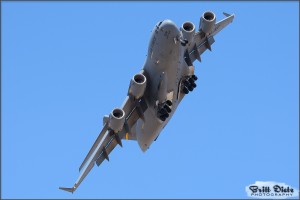 A bit past noon, we heard over the scanner radio that was tuned into the tower that the C-17 was on it’s way.  It didn’t take long at all to start to see the large spot in the sky grow larger and larger until it was unmistakably a C-17.  Coming in very loud as if to have roaring trumpeters bringing it in, the C-17 made a sweeping pass over the field and began it’s tactical demonstration.  Banking around the airport and stopping all who had been working to set up the airshow for a moment’s rest as they watched the massive plane fly around all photographer’s lenses were pointed to the sky.  I couldn’t help but think about how I’d be soon in that aircraft and flying to what at that point was an unknown location.  As the demo started to draw to a close, the Air Force personnel announced that they’d be rounding us up as soon as the C-17 lands.  After coming in and performing a short field landing, I found myself hoping we’d do a tactical assault landing so I could see how it feels to land in about the length of a football field and some.  After the C-17 performed a quick reverse thrust demo backing up to the cross runway, it turned and taxied into position and dropped the aft cargo ramp for us.  At this point all of the media were taken downstairs and we were escorted over to the C-17 across aircraft parking areas on the airport.
A bit past noon, we heard over the scanner radio that was tuned into the tower that the C-17 was on it’s way.  It didn’t take long at all to start to see the large spot in the sky grow larger and larger until it was unmistakably a C-17.  Coming in very loud as if to have roaring trumpeters bringing it in, the C-17 made a sweeping pass over the field and began it’s tactical demonstration.  Banking around the airport and stopping all who had been working to set up the airshow for a moment’s rest as they watched the massive plane fly around all photographer’s lenses were pointed to the sky.  I couldn’t help but think about how I’d be soon in that aircraft and flying to what at that point was an unknown location.  As the demo started to draw to a close, the Air Force personnel announced that they’d be rounding us up as soon as the C-17 lands.  After coming in and performing a short field landing, I found myself hoping we’d do a tactical assault landing so I could see how it feels to land in about the length of a football field and some.  After the C-17 performed a quick reverse thrust demo backing up to the cross runway, it turned and taxied into position and dropped the aft cargo ramp for us.  At this point all of the media were taken downstairs and we were escorted over to the C-17 across aircraft parking areas on the airport.
As we approached the C-17, they had ever stop for a moment so everyone could get some shots of the C-17 before we went inside. Â It seemed like a long time as we were standing there shooting, but I’m sure that was just the anticipation to enter the massive aircraft. Â 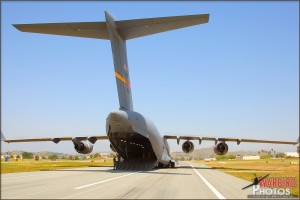 The engines were still running very loudly, and they made sure at this point we all had ear plugs in for protection as it was going to get very loud. Â As soon as everyone got all the photos they needed, we walked towards the towering tail of the C-17 and stepped foot on the ramp headed inside. Â There were two loadmasters overseeing us onboard, on headset to communicate to the rest of the crew. Â The C-17A Globemaster III was from March Air Reserve Base, part of the 452nd Air Mobility Wing and crewed by personnel and pilots from the US Air Force Reserve. Upon walking up the ramp into the C-17, the crew asked us after a few moments of us all taking photos to find a seat and to get our things secured because the take-off would be quite a jolt. Â A few fellow photographers mentioned the same thing as well, saying I should be sure to have every piece of camera equipment secured because it’s quite the ride on takeoff. Â Sitting down and buckling in and making sure all my equipment was around my neck or buckled into the seat next to me, we were given instructions on emergency procedures, much like an airliner, from the crew. Â After that was all done and they did brief checks to make sure we were ready, they gave the thumbs up as the ramp raised into the air sealing us in the giant beast. Â We heard the powerful engines roar loader as we started to taxi for the runway.
The engines were still running very loudly, and they made sure at this point we all had ear plugs in for protection as it was going to get very loud. Â As soon as everyone got all the photos they needed, we walked towards the towering tail of the C-17 and stepped foot on the ramp headed inside. Â There were two loadmasters overseeing us onboard, on headset to communicate to the rest of the crew. Â The C-17A Globemaster III was from March Air Reserve Base, part of the 452nd Air Mobility Wing and crewed by personnel and pilots from the US Air Force Reserve. Upon walking up the ramp into the C-17, the crew asked us after a few moments of us all taking photos to find a seat and to get our things secured because the take-off would be quite a jolt. Â A few fellow photographers mentioned the same thing as well, saying I should be sure to have every piece of camera equipment secured because it’s quite the ride on takeoff. Â Sitting down and buckling in and making sure all my equipment was around my neck or buckled into the seat next to me, we were given instructions on emergency procedures, much like an airliner, from the crew. Â After that was all done and they did brief checks to make sure we were ready, they gave the thumbs up as the ramp raised into the air sealing us in the giant beast. Â We heard the powerful engines roar loader as we started to taxi for the runway.
There are not many ways to look outside of the C-17, and if you’re not standing right in front of one of the 3 port windows on either side of the aircraft that are only about 7 inches in diameter, then you really have no idea what’s going on outside.  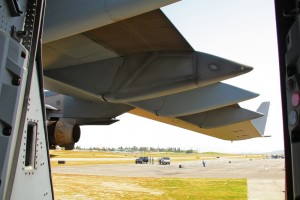 We had to ‘feel’ in what direction the plane was heading or turning for us to have sense of where we were on the airport. I could barely see the tip tops of the trees through one of the little port windows across from me that look out really high towards the wing… but even still I could barely see anything except the occasional branch pass by in a millisecond.  Making a U turn at the end of the runway (at least I think we did), we lined up and were ready to go as the brakes were set and we came to a stop. Everyone in the aircraft was filming or taking photos with whatever they had.  A few people were using cellphones to record video, some were shooting still images from their cameras.  A News Media group was shooting with their larger video camera as we waited for the engines to spool up and the breaks to be released.  I took the moment to really enjoy the takeoff, taking photos ever so often but making sure I wasn’t too lost in getting shots. It wasn’t long before we heard the engines roar to life at maximum thrust… and then it was time for the breaks to come off.
We had to ‘feel’ in what direction the plane was heading or turning for us to have sense of where we were on the airport. I could barely see the tip tops of the trees through one of the little port windows across from me that look out really high towards the wing… but even still I could barely see anything except the occasional branch pass by in a millisecond.  Making a U turn at the end of the runway (at least I think we did), we lined up and were ready to go as the brakes were set and we came to a stop. Everyone in the aircraft was filming or taking photos with whatever they had.  A few people were using cellphones to record video, some were shooting still images from their cameras.  A News Media group was shooting with their larger video camera as we waited for the engines to spool up and the breaks to be released.  I took the moment to really enjoy the takeoff, taking photos ever so often but making sure I wasn’t too lost in getting shots. It wasn’t long before we heard the engines roar to life at maximum thrust… and then it was time for the breaks to come off.
Many people have been on roller coasters that might suddenly launch you from nothing to incredible speeds.  Sometimes even airliners do that to get rolling with maximum force.  Unless you’ve an F/A-18 Hornet pilot being catapulted off the deck of an aircraft carrier, you really don’t know what it’s like to be slingshot an huge speeds. 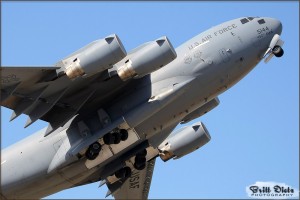 I think I can safely say I had a little tiny glimpse of what incredible power of a carrier catapult.  When the C-17 let off the breaks, it seemed like someone yanked the C-17 forward, and naturally I wasn’t ready for it so it felt like I was going to immediately go flying and splat against the back of the plane like those cartoons with Bugs Bunny.  Thankfully, I was strapped in to the seat, but I now understand why they stress to have all you equipment secured.  The launch of the C-17 was amazing, and I couldn’t help but laugh (as many others did) at the sheer force of being accelerated that fast.  Because the main runway at Riverside Airport is only 5,400 feet long, the C-17 performed a short field take-off (while that’s still nearly 2,000 feet longer than it’s minimum runway requirements, I think they also wanted to give us a real C-17 ride) and launched into the air.  It wasn’t long before I felt the feeling of being weightless, and I realized we were rapidly rising.  The C-17 spun around the airport gaining altitude, and ever so often I could see through the little port window across the way some glimpses of land as the wing dipped as we spiraled upwards.  To me, it only seemed like a matter of seconds from take-off until we were at altitude and they made the announcement that we could get up and walk around.
I think I can safely say I had a little tiny glimpse of what incredible power of a carrier catapult.  When the C-17 let off the breaks, it seemed like someone yanked the C-17 forward, and naturally I wasn’t ready for it so it felt like I was going to immediately go flying and splat against the back of the plane like those cartoons with Bugs Bunny.  Thankfully, I was strapped in to the seat, but I now understand why they stress to have all you equipment secured.  The launch of the C-17 was amazing, and I couldn’t help but laugh (as many others did) at the sheer force of being accelerated that fast.  Because the main runway at Riverside Airport is only 5,400 feet long, the C-17 performed a short field take-off (while that’s still nearly 2,000 feet longer than it’s minimum runway requirements, I think they also wanted to give us a real C-17 ride) and launched into the air.  It wasn’t long before I felt the feeling of being weightless, and I realized we were rapidly rising.  The C-17 spun around the airport gaining altitude, and ever so often I could see through the little port window across the way some glimpses of land as the wing dipped as we spiraled upwards.  To me, it only seemed like a matter of seconds from take-off until we were at altitude and they made the announcement that we could get up and walk around.
The plane had leveled out and by the time I got to one of the port windows, we were nearing the ocean already. Â I was amazed at how fast we had gotten over Orange County and were heading towards the beaches. Â 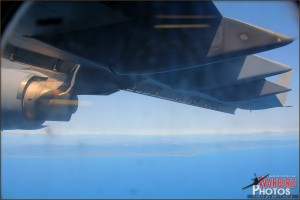 Taking a few moments to go to each port window and check out the limited but unique views of each one, I could see we were travelling at a pretty nice cruising speed, probably pittance for the C-17. They informed us that we’d be able to go up to the cockpit, visit with the pilots and check out the controls one at a time, I decided to wait since there was no real rush. Â I spent time snapping shots in the C-17 and out the windows, chatting with other photographers and enjoying the relatively smooth flight. Â It was pretty loud, but with the ear plugs in it wasn’t really that bad (I think a B-25 with the waist windows open is much louder in my opinion). Â Ever so often the pilot would correct a heading and the wings would dip a bit, but otherwise it was a pretty straight flight. Â Flying out past the coast, we turned right and paralleled the beaches as we headed north towards the Catalina. Â I could only imagine, looking down at the city below, how many people had looked up to see the massive C-17 pass overhead and how many more people didn’t even realize we were up here.
Taking a few moments to go to each port window and check out the limited but unique views of each one, I could see we were travelling at a pretty nice cruising speed, probably pittance for the C-17. They informed us that we’d be able to go up to the cockpit, visit with the pilots and check out the controls one at a time, I decided to wait since there was no real rush. Â I spent time snapping shots in the C-17 and out the windows, chatting with other photographers and enjoying the relatively smooth flight. Â It was pretty loud, but with the ear plugs in it wasn’t really that bad (I think a B-25 with the waist windows open is much louder in my opinion). Â Ever so often the pilot would correct a heading and the wings would dip a bit, but otherwise it was a pretty straight flight. Â Flying out past the coast, we turned right and paralleled the beaches as we headed north towards the Catalina. Â I could only imagine, looking down at the city below, how many people had looked up to see the massive C-17 pass overhead and how many more people didn’t even realize we were up here.
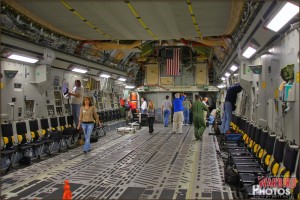
Soon the line to go up to the cockpit started to thin out, so I decided it was about time to head on up there. Â Climbing a small ladder (which if in turbulent weather or when performing evasive maneuvers would be impossible to climb) up to the second level of the C-17, you come into the mini ‘quarters’ of the C-17 that has a few small cramped bunks and a bubble window that looks down into the main cargo hold where I just was. Â 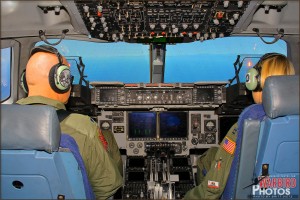 Walking into the cockpit, you realize how comfortable it overall is up there for the pilots. Â There’s no exposed wiring and insulation like in the main part of the plane, just a lot of switches and controls. Â A high tech Heads up Display (or HUD) provides the pilot and copilot with information on their altitude and speed as they look forward, and tons of various LCD screens give them expanded information on the performance, status, and location of the plane. Â A really neat feature, I thought, was a little tablet running a Windows software that had a cool precision GPS software system on it that pinpointed the C-17s exact location. Â Looking at this tablet I realized we were flying directly over Catalina Island off the coast. Â Looking through the pilot’s side window, I could just barely see below us the rocky shores of Catalina, and I wondered once again what those people on the island were thinking as the otherwise quiet skies over their island just came to life with a C-17. Â I snapped some shots of the cockpit as I talked with one of the crew members about some of the features of the C-17 and it’s capabilities. Â Soon it became time for me to leave the cockpit and let some of the last few people come on up. Â During this time we started to turn inward to make our round about way back to Riverside Airport.
Walking into the cockpit, you realize how comfortable it overall is up there for the pilots. Â There’s no exposed wiring and insulation like in the main part of the plane, just a lot of switches and controls. Â A high tech Heads up Display (or HUD) provides the pilot and copilot with information on their altitude and speed as they look forward, and tons of various LCD screens give them expanded information on the performance, status, and location of the plane. Â A really neat feature, I thought, was a little tablet running a Windows software that had a cool precision GPS software system on it that pinpointed the C-17s exact location. Â Looking at this tablet I realized we were flying directly over Catalina Island off the coast. Â Looking through the pilot’s side window, I could just barely see below us the rocky shores of Catalina, and I wondered once again what those people on the island were thinking as the otherwise quiet skies over their island just came to life with a C-17. Â I snapped some shots of the cockpit as I talked with one of the crew members about some of the features of the C-17 and it’s capabilities. Â Soon it became time for me to leave the cockpit and let some of the last few people come on up. Â During this time we started to turn inward to make our round about way back to Riverside Airport.
After carefully climbing down the ladder, I went right towards one of the near port windows to watch as we came back over the coast and headed inland. 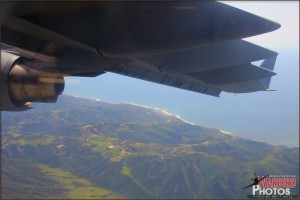 Trying to gauge where we were at this point, I spotted a military air base installation below us, and took some photos so I could try and figure out what it was. After taking a closer look at the photos, I realized we were going past NBVC Point Mugu in Ventura.  We’d gone about 150 miles up the coast and turned inland.  Something that would take 2 hours to get to by car took what felt like 10 minutes, but was probably more like 20 or 30 if even that much.  Flying over the Camarillo and Simi Valley heading towards Burbank, I spotted Universal Studios and the unmistakable skyline of Los Angeles in the distance.  Realizing that we were heading back towards Riverside I tried to take as many photos as I could and enjoy the last leg of the flight.  At this point, it still seemed like we had just taken off from Riverside, and that it had only been a couple minutes.  Once again, ever so often the pilot would make slight adjustments, and you could feel the whole plan lean to one side as we banked slightly to correct the heading.  Those were only slight banks, I can’t imagine what the extreme banks demonstrated by the C-17 at airshows feel like.  That has to be a rush!
Trying to gauge where we were at this point, I spotted a military air base installation below us, and took some photos so I could try and figure out what it was. After taking a closer look at the photos, I realized we were going past NBVC Point Mugu in Ventura. Â We’d gone about 150 miles up the coast and turned inland. Â Something that would take 2 hours to get to by car took what felt like 10 minutes, but was probably more like 20 or 30 if even that much. Â Flying over the Camarillo and Simi Valley heading towards Burbank, I spotted Universal Studios and the unmistakable skyline of Los Angeles in the distance. Â Realizing that we were heading back towards Riverside I tried to take as many photos as I could and enjoy the last leg of the flight. Â At this point, it still seemed like we had just taken off from Riverside, and that it had only been a couple minutes. Â Once again, ever so often the pilot would make slight adjustments, and you could feel the whole plan lean to one side as we banked slightly to correct the heading. Â Those were only slight banks, I can’t imagine what the extreme banks demonstrated by the C-17 at airshows feel like. Â That has to be a rush!
It wasn’t long before the crew members started to announce that ever should take their seats in preparation for landing.  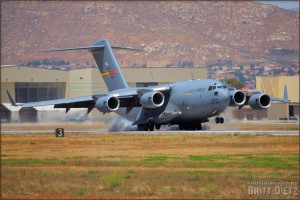 After strapping ourselves back in and our equipment secured, they announced that we’d be be doing a tactical landing because of the runway length and (apparently) some other factors.  I was really hoping for a landing like this, as it looks like one heck of a hard landing when you watch them perform it at the airshows.  A tactical landing basically is where they slow the plane down as much as possible and almost pretty much slam on the runway so that they can immediately put on reverse thrust to stop the aircraft on a very small runway. This is standard procedure for an aircraft like this on small fields, and is one of the most amazing capabilities of the C-17.  We continued to fly for a bit, and now I had lost all sense of where we were in the flight pattern.  Ever so often we’d make a pretty good bank, and I’d see the ground for a millisecond through that little port window.  We were getting lower and lower with each time I had a little glimpse.  Now all we could do and was wait for the moment of impact.  There would be no warning, just BAM! I decided to take some video with my phone of this landing as it’d be the only way to really describe how the landing would feel.  We waited and waited… the aircraft was descending fast.  Then out of no where, with what sounded like a giant explosion, we hit the ground hard.  Hard enough that it really startled me and I almost dropped my phone.  Just as soon as we hit, the reverse thrusters came on and G forces threw us in our straps towards the front of the plane.  It lasted just seconds, but suddenly the speed decreased with sudden force and the engines loud roar died down as we had landed and slowed enough to taxi.  A few people clapped, myself included, at the rush of the landing.  You couldn’t help but smile and laugh at what had just happened.
After strapping ourselves back in and our equipment secured, they announced that we’d be be doing a tactical landing because of the runway length and (apparently) some other factors.  I was really hoping for a landing like this, as it looks like one heck of a hard landing when you watch them perform it at the airshows.  A tactical landing basically is where they slow the plane down as much as possible and almost pretty much slam on the runway so that they can immediately put on reverse thrust to stop the aircraft on a very small runway. This is standard procedure for an aircraft like this on small fields, and is one of the most amazing capabilities of the C-17.  We continued to fly for a bit, and now I had lost all sense of where we were in the flight pattern.  Ever so often we’d make a pretty good bank, and I’d see the ground for a millisecond through that little port window.  We were getting lower and lower with each time I had a little glimpse.  Now all we could do and was wait for the moment of impact.  There would be no warning, just BAM! I decided to take some video with my phone of this landing as it’d be the only way to really describe how the landing would feel.  We waited and waited… the aircraft was descending fast.  Then out of no where, with what sounded like a giant explosion, we hit the ground hard.  Hard enough that it really startled me and I almost dropped my phone.  Just as soon as we hit, the reverse thrusters came on and G forces threw us in our straps towards the front of the plane.  It lasted just seconds, but suddenly the speed decreased with sudden force and the engines loud roar died down as we had landed and slowed enough to taxi.  A few people clapped, myself included, at the rush of the landing.  You couldn’t help but smile and laugh at what had just happened.
With the aircraft now taxiing to where it’d spend the night until it’s moment to shine the next day at the airshow, the crew members got up and lowered the ramp half way so we could see out the back of the aircraft as we were moving across the runway.  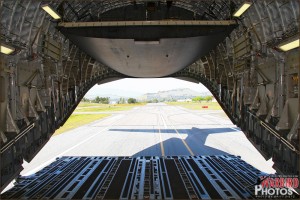 Soon we taxied to a stop at the C-17s parking spot, and they announced we were free to get up and that they hoped we enjoyed the flight.  Everyone stood up and grabbed their things taking shots of the aircraft one last time before either chatting with the pilots and crew, who all came down to greet us after they had shut down the aircraft, or departing the plane and heading for home with the amazing experience they just had fresh in their minds to convey to the world through their media outlets.  I went over and listened to the pilot speak a bit about their demo schedule for the year and some other fun upcoming airshow news items before I thanked him and the cockpit of their wonderful flight, and I departed the plane.  I took some time to take photos of the plane without the massive crowds around it that would disrupt the perfect shot the next day at the airshow.  After getting a few different angles of the massive C-17 as she rested from her flight, I decided to call it a day with my head still up in the air over what I’d just experienced.
Soon we taxied to a stop at the C-17s parking spot, and they announced we were free to get up and that they hoped we enjoyed the flight.  Everyone stood up and grabbed their things taking shots of the aircraft one last time before either chatting with the pilots and crew, who all came down to greet us after they had shut down the aircraft, or departing the plane and heading for home with the amazing experience they just had fresh in their minds to convey to the world through their media outlets.  I went over and listened to the pilot speak a bit about their demo schedule for the year and some other fun upcoming airshow news items before I thanked him and the cockpit of their wonderful flight, and I departed the plane.  I took some time to take photos of the plane without the massive crowds around it that would disrupt the perfect shot the next day at the airshow.  After getting a few different angles of the massive C-17 as she rested from her flight, I decided to call it a day with my head still up in the air over what I’d just experienced.
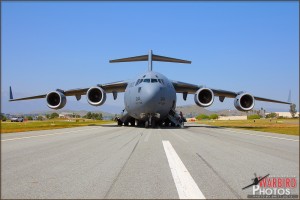
The C-17 flight was one of the best moments of 2010 for me, and something I thought was only wishful thinking and not possible for myself to be able to take part in.  Hopefully the opportunity will arise again sometime in the future for another flight, but if not I’ll carry the memories of this one for the rest of my life.  I always think about the flight when I see the C-17 parked or performing at the various airshows I attend, especially since the particular aircraft I flew on is the aircraft that performs the demos all around the west coast.  The C-17 certainly captured a special place with me, and I encourage everyone I know to go out and check out the C-17 at an airshow if you can.  I guarantee you’ll watch it in amazement and wonder as the massive machine of beauty roars through the air.
For more photos on the flight you can click here for the gallery from the Media Day, and photos here of the 2010 Riverside Airshow.
For more photos of the C-17, you can click here for all the photos I’ve taken and posted of the C-17 from various airshows over the years.
I’d like to thank Clark Cook and Roberta Longridge, along with the crew of the C-17 from the 452nd AMW at March Air Reserve Base for memories that will last a lifetime!
[ad name=”GA1″]

















